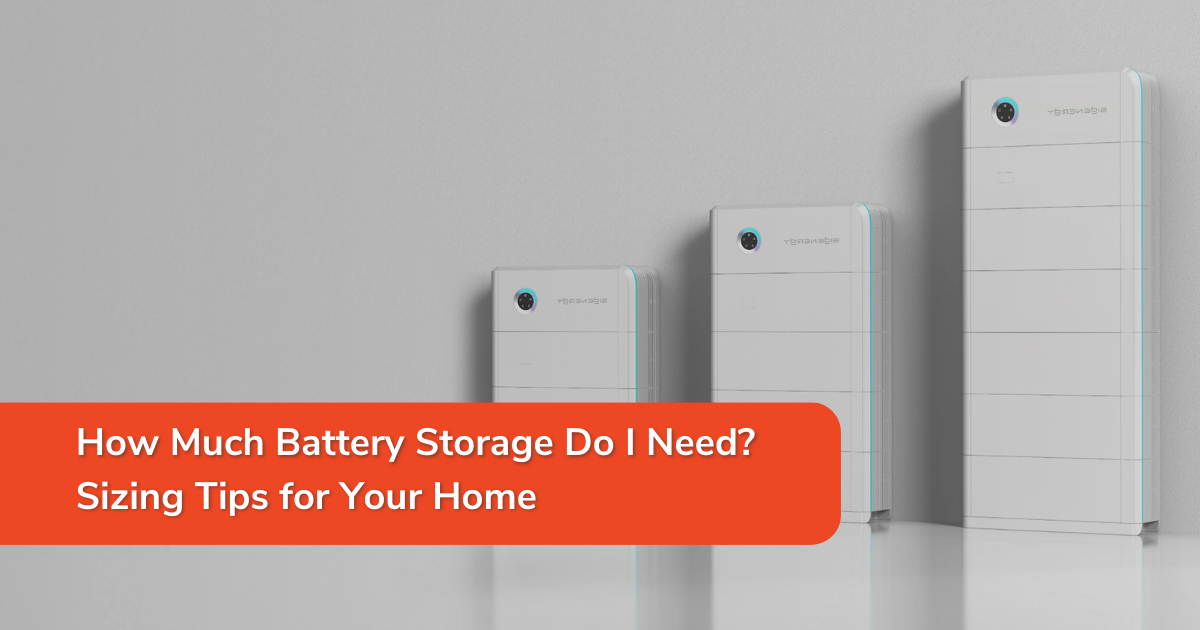How Much Battery Storage Do I Need? Sizing Tips for Your Home

As solar adoption continues to rise, more homeowners are considering solar batteries to store their excess energy and gain greater energy independence. But how much battery storage do you actually need? The answer depends on a few key factors—your daily electricity usage, your solar system size, and how you plan to use your stored energy.
1. Understand Your Daily Energy Usage
To accurately size your solar battery, start by reviewing your electricity bill and noting both your average daily usage and seasonal variations. The average Australian home uses between 15–25 kWh per day, but this can vary widely based on several factors. Larger families or homes with multiple high-consumption appliances—like electric water heaters, air conditioning, or pool pumps—may use more energy. Additionally, if you work from home or spend more time indoors during the day, your daytime consumption will be higher. Understanding your energy patterns across weekdays, weekends, and seasons is crucial for sizing a battery that truly meets your needs.
2. Consider Your Solar Panel Output
If you already have solar panels, take a close look at how much energy your system generates on average each day—this will be key in determining the right battery size. Ideally, your battery should be large enough to store the surplus energy your panels produce after your daytime consumption needs are met. For example, a standard 6.6kW solar system might generate around 25 kWh per day. If your household uses about 10 kWh during daylight hours, that leaves approximately 15 kWh available for storage. Having a battery that can store this excess allows you to use your own solar energy at night, reducing reliance on the grid and maximising your return on investment. Seasonal production and orientation of panels can also impact this figure, so monitoring your solar generation over time helps inform a more precise battery sizing.
3. Think About How You’ll Use the Battery
For Night-time Use Only
A battery with 10-15 kWh capacity is often enough to power most homes through the evening and early morning.For Backup Power During Outages
Consider a larger battery (e.g., 13.5 kWh Tesla Powerwall or 24 kWh Sigenergy system) to run essential appliances during blackouts.
For Going Off-Grid
You’ll need significant battery capacity (often 30–50 kWh or more), especially with limited grid access.
For VPP Use
If you're planning to connect your battery to a Virtual Power Plant (VPP) in order to maximise your return on investment (ROI), then it is advisable to consider a larger battery, typically 5-10 kWh extra.
4. Factor in Battery Efficiency and Depth of Discharge (DoD)
Most lithium batteries don’t use 100% of their rated capacity. For example, a 10 kWh battery with a 90% DoD will deliver around 9 kWh of usable energy. Always check usable capacity when comparing systems, as this figure determines how much power you'll actually be able to draw. Also consider the round-trip efficiency, which reflects energy losses during charging and discharging—most modern batteries offer around 90–95% efficiency.5. Plan for Future Usage
If you’re planning to buy an EV, add new appliances like a pool pump or ducted air conditioning, or expand your household, it’s wise to oversize your battery slightly now to future-proof your investment. Batteries can last 10+ years, so planning ahead ensures you won’t need a costly upgrade later.
Final Thoughts
There’s no one-size-fits-all solution when it comes to battery storage. The right capacity for your home depends on your goals, usage patterns, and how self-sufficient you want to be. Our experts at Smart Energy Answers can help design a battery solution tailored to your energy needs.
As the Federal Battery Rebate has just been announced, this is the perfect time to get a solar battery.
Need help sizing your home battery? Contact us today for a free energy consultation and personalised quote.
%20(1).png?width=265&height=96&name=www.smartenergyanswers.com.auhs-fshubfsSmart%20Energy%20Answers%20Logo%20(HIRES)%20(1).png)

.png?width=514&height=121&name=Tesla%20Powerwall%203%20(new).png)








.webp?width=300&height=180&name=sigenergy-gold-installer-300x180%20(1).webp)